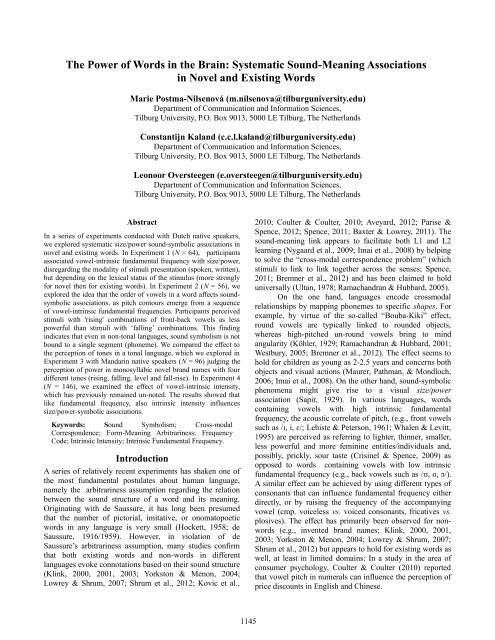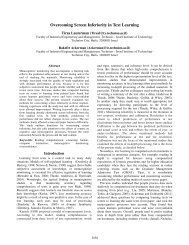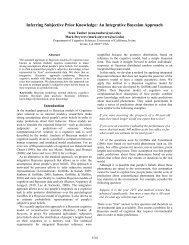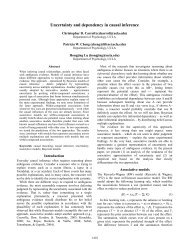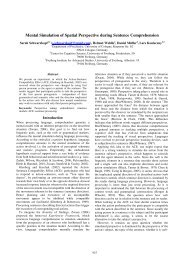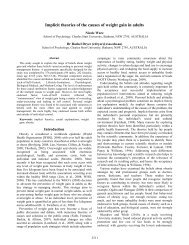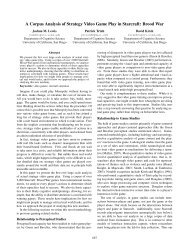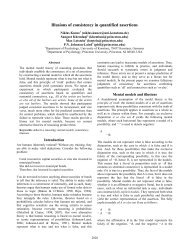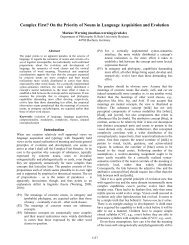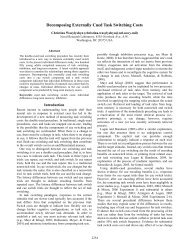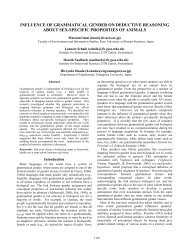Systematic Sound-Meaning Associations in Novel and Existing Words
Systematic Sound-Meaning Associations in Novel and Existing Words
Systematic Sound-Meaning Associations in Novel and Existing Words
Create successful ePaper yourself
Turn your PDF publications into a flip-book with our unique Google optimized e-Paper software.
The Power of <strong>Words</strong> <strong>in</strong> the Bra<strong>in</strong>: <strong>Systematic</strong> <strong>Sound</strong>-<strong>Mean<strong>in</strong>g</strong> <strong>Associations</strong><br />
<strong>in</strong> <strong>Novel</strong> <strong>and</strong> Exist<strong>in</strong>g <strong>Words</strong><br />
Marie Postma-Nilsenová (m.nilsenova@tilburguniversity.edu)<br />
Department of Communication <strong>and</strong> Information Sciences,<br />
Tilburg University, P.O. Box 9013, 5000 LE Tilburg, The Netherl<strong>and</strong>s<br />
Constantijn Kal<strong>and</strong> (c.c.l.kal<strong>and</strong>@tilburguniversity.edu)<br />
Department of Communication <strong>and</strong> Information Sciences,<br />
Tilburg University, P.O. Box 9013, 5000 LE Tilburg, The Netherl<strong>and</strong>s<br />
Leonoor Oversteegen (e.oversteegen@tilburguniversity.edu)<br />
Department of Communication <strong>and</strong> Information Sciences,<br />
Tilburg University, P.O. Box 9013, 5000 LE Tilburg, The Netherl<strong>and</strong>s<br />
Abstract<br />
In a series of experiments conducted with Dutch native speakers,<br />
we explored systematic size/power sound-symbolic associations <strong>in</strong><br />
novel <strong>and</strong> exist<strong>in</strong>g words. In Experiment 1 (N = 64), participants<br />
associated vowel-<strong>in</strong>tr<strong>in</strong>sic fundamental frequency with size/power,<br />
disregard<strong>in</strong>g the modality of stimuli presentation (spoken, written),<br />
but depend<strong>in</strong>g on the lexical status of the stimulus (more strongly<br />
for novel then for exist<strong>in</strong>g words). In Experiment 2 (N = 56), we<br />
explored the idea that the order of vowels <strong>in</strong> a word affects soundsymbolic<br />
associations, as pitch contours emerge from a sequence<br />
of vowel-<strong>in</strong>tr<strong>in</strong>sic fundamental frequencies. Participants perceived<br />
stimuli with 'ris<strong>in</strong>g' comb<strong>in</strong>ations of front-back vowels as less<br />
powerful than stimuli with ‘fall<strong>in</strong>g’ comb<strong>in</strong>ations. This f<strong>in</strong>d<strong>in</strong>g<br />
<strong>in</strong>dicates that even <strong>in</strong> non-tonal languages, sound symbolism is not<br />
bound to a s<strong>in</strong>gle segment (phoneme). We compared the effect to<br />
the perception of tones <strong>in</strong> a tonal language, which we explored <strong>in</strong><br />
Experiment 3 with M<strong>and</strong>ar<strong>in</strong> native speakers (N = 96) judg<strong>in</strong>g the<br />
perception of power <strong>in</strong> monosyllabic novel br<strong>and</strong> names with four<br />
different tones (ris<strong>in</strong>g, fall<strong>in</strong>g, level <strong>and</strong> fall-rise). In Experiment 4<br />
(N = 146), we exam<strong>in</strong>ed the effect of vowel-<strong>in</strong>tr<strong>in</strong>sic <strong>in</strong>tensity,<br />
which has previously rema<strong>in</strong>ed un-noted. The results showed that<br />
like fundamental frequency, also <strong>in</strong>tr<strong>in</strong>sic <strong>in</strong>tensity <strong>in</strong>fluences<br />
size/power-symbolic associations.<br />
Keywords: <strong>Sound</strong> Symbolism; Cross-modal<br />
Correspondence; Form-<strong>Mean<strong>in</strong>g</strong> Arbitrar<strong>in</strong>ess; Frequency<br />
Code; Intr<strong>in</strong>sic Intensity; Intr<strong>in</strong>sic Fundamental Frequency.<br />
Introduction<br />
A series of relatively recent experiments has shaken one of<br />
the most fundamental postulates about human language,<br />
namely the arbitrar<strong>in</strong>ess assumption regard<strong>in</strong>g the relation<br />
between the sound structure of a word <strong>and</strong> its mean<strong>in</strong>g.<br />
Orig<strong>in</strong>at<strong>in</strong>g with de Saussure, it has long been presumed<br />
that the number of pictorial, imitative, or onomatopoetic<br />
words <strong>in</strong> any language is very small (Hockett, 1958; de<br />
Saussure, 1916/1959). However, <strong>in</strong> violation of de<br />
Saussure’s arbitrar<strong>in</strong>ess assumption, many studies confirm<br />
that both exist<strong>in</strong>g words <strong>and</strong> non-words <strong>in</strong> different<br />
languages evoke connotations based on their sound structure<br />
(Kl<strong>in</strong>k, 2000, 2001, 2003; Yorkston & Menon, 2004;<br />
Lowrey & Shrum, 2007; Shrum et al., 2012; Kovic et al.,<br />
1145<br />
2010; Coulter & Coulter, 2010; Aveyard, 2012; Parise &<br />
Spence, 2012; Spence, 2011; Baxter & Lowrey, 2011). The<br />
sound-mean<strong>in</strong>g l<strong>in</strong>k appears to facilitate both L1 <strong>and</strong> L2<br />
learn<strong>in</strong>g (Nygaard et al., 2009; Imai et al., 2008) by help<strong>in</strong>g<br />
to solve the “cross-modal correspondence problem” (which<br />
stimuli to l<strong>in</strong>k to l<strong>in</strong>k together across the senses; Spence,<br />
2011; Bremner et al., 2012) <strong>and</strong> has been claimed to hold<br />
universally (Ultan, 1978; Ramach<strong>and</strong>ran & Hubbard, 2005).<br />
On the one h<strong>and</strong>, languages encode crossmodal<br />
relationships by mapp<strong>in</strong>g phonemes to specific shapes. For<br />
example, by virtue of the so-called “Bouba-Kiki” effect,<br />
round vowels are typically l<strong>in</strong>ked to rounded objects,<br />
whereas high-pitched un-round vowels br<strong>in</strong>g to m<strong>in</strong>d<br />
angularity (Köhler, 1929; Ramach<strong>and</strong>ran & Hubbard, 2001;<br />
Westbury, 2005; Bremner et al., 2012). The effect seems to<br />
hold for children as young as 2-2.5 years <strong>and</strong> concerns both<br />
objects <strong>and</strong> visual actions (Maurer, Pathman, & Mondloch,<br />
2006; Imai et al., 2008). On the other h<strong>and</strong>, sound-symbolic<br />
phenomena might give rise to a visual size/power<br />
association (Sapir, 1929). In various languages, words<br />
conta<strong>in</strong><strong>in</strong>g vowels with high <strong>in</strong>tr<strong>in</strong>sic fundamental<br />
frequency, the acoustic correlate of pitch, (e.g., front vowels<br />
such as /ɪ, i, ɛ/; Lehiste & Peterson, 1961; Whalen & Levitt,<br />
1995) are perceived as referr<strong>in</strong>g to lighter, th<strong>in</strong>ner, smaller,<br />
less powerful <strong>and</strong> more fem<strong>in</strong><strong>in</strong>e entities/<strong>in</strong>dividuals <strong>and</strong>,<br />
possibly, prickly, sour taste (Cris<strong>in</strong>el & Spence, 2009) as<br />
opposed to words conta<strong>in</strong><strong>in</strong>g vowels with low <strong>in</strong>tr<strong>in</strong>sic<br />
fundamental frequency (e.g., back vowels such as /ʊ, o, ɔ/).<br />
A similar effect can be achieved by us<strong>in</strong>g different types of<br />
consonants that can <strong>in</strong>fluence fundamental frequency either<br />
directly, or by rais<strong>in</strong>g the frequency of the accompany<strong>in</strong>g<br />
vowel (cmp. voiceless vs. voiced consonants, fricatives vs.<br />
plosives). The effect has primarily been observed for nonwords<br />
(e.g., <strong>in</strong>vented br<strong>and</strong> names; Kl<strong>in</strong>k, 2000, 2001,<br />
2003; Yorkston & Menon, 2004; Lowrey & Shrum, 2007;<br />
Shrum et al., 2012) but appears to hold for exist<strong>in</strong>g words as<br />
well, at least <strong>in</strong> limited doma<strong>in</strong>s: In a study <strong>in</strong> the area of<br />
consumer psychology, Coulter & Coulter (2010) reported<br />
that vowel pitch <strong>in</strong> numerals can <strong>in</strong>fluence the perception of<br />
price discounts <strong>in</strong> English <strong>and</strong> Ch<strong>in</strong>ese.
The association between pitch <strong>and</strong> size/power can, for the<br />
most part, be expla<strong>in</strong>ed by the mechanism of the Frequency<br />
Code (Ohala 1994; Gussenhoven, 2004), a psychol<strong>in</strong>guistic<br />
pr<strong>in</strong>ciple primarily used to account for <strong>in</strong>terpretational<br />
effects of ris<strong>in</strong>g <strong>and</strong> fall<strong>in</strong>g utterance contours <strong>in</strong> different<br />
languages (Chen, 2004). Accord<strong>in</strong>g to the Frequency Code,<br />
high pitch is l<strong>in</strong>ked to smaller immature speakers (with<br />
th<strong>in</strong>ner, smaller vocal folds <strong>and</strong> shorter vocal tracts<br />
produc<strong>in</strong>g higher fundamental frequency) <strong>and</strong>, hence,<br />
utterances carry<strong>in</strong>g high <strong>and</strong>/or ris<strong>in</strong>g pitch are <strong>in</strong>terpreted<br />
as less dom<strong>in</strong>ant, more uncerta<strong>in</strong>, friendlier <strong>and</strong> question<strong>in</strong>g.<br />
Presumably, the effects of the Frequency Code can be<br />
translated from the suprasegmental doma<strong>in</strong> (utterance<br />
prosody) to the micro-prosodic, segmental doma<strong>in</strong>, <strong>and</strong><br />
affect mean<strong>in</strong>g with the help of motor-imitative mechanisms<br />
associated with speech perception.<br />
Current Study<br />
In our current study, we attempted to explore further the<br />
effect of phonetic segment-<strong>in</strong>tr<strong>in</strong>sic properties on<br />
<strong>in</strong>terpretation of words <strong>and</strong> non-words. Surpris<strong>in</strong>gly, past<br />
research of the sound-referent cross-modal mapp<strong>in</strong>gs mostly<br />
<strong>in</strong>volved written presentation of stimuli. Given that the<br />
Frequency Code is grounded <strong>in</strong> pr<strong>in</strong>ciples of speech<br />
production, the question arises what role the modality of<br />
presentation plays <strong>in</strong> the sound-size association. Are sound<br />
symbolic effects stronger if words are presented aurally<br />
rather than visually? Moreover, accord<strong>in</strong>g to most models of<br />
read<strong>in</strong>g (Coltheart, 2006; Coltheart, 2012), unlike exist<strong>in</strong>g<br />
words, pseudo-words <strong>and</strong> non-words can only be<br />
pronounced with the help of a system that associates visual<br />
segments (i.e., graphemes) with sounds. Are soundsymbolic<br />
effects stronger for pseudo-words <strong>and</strong> non-words<br />
than for exist<strong>in</strong>g words? We addressed these two questions<br />
<strong>in</strong> Experiment 1 conducted with Dutch native speakers.<br />
Exist<strong>in</strong>g research <strong>in</strong> the area of phonetic symbolism<br />
has, so far, disregarded the possibility that not just<br />
<strong>in</strong>dividual phonemes, but also their sequences, might create<br />
mean<strong>in</strong>gful associations between phoneme-<strong>in</strong>tr<strong>in</strong>sic<br />
fundamental frequency <strong>and</strong> mean<strong>in</strong>g, by virtue of produc<strong>in</strong>g<br />
a micro-prosodic contour. For example, <strong>in</strong> words consist<strong>in</strong>g<br />
of two syllables, a sequence of high-low vowels<br />
(e.g., /CɪCɔ/) produces a “fall<strong>in</strong>g contour”, while the<br />
opposite sequence (/CɔCɪ/) produces a “ris<strong>in</strong>g contour”. In<br />
accordance with the predictions of the Frequency Code<br />
(Gussenhoven, 2004; Chen, 2004), these two contours<br />
should receive different <strong>in</strong>terpretations (big/powerful <strong>and</strong><br />
small/powerless, respectively). Do sound-symbolic<br />
associations vary with different sequenc<strong>in</strong>g of high- <strong>and</strong><br />
low-pitched phonemes <strong>in</strong> a word? We explored the issue <strong>in</strong><br />
Experiment 2 <strong>and</strong> compared the outcomes collected for a<br />
non-tonal language (Dutch) with perceptions of lexical tones<br />
<strong>in</strong> a tonal language (M<strong>and</strong>ar<strong>in</strong> Ch<strong>in</strong>ese) <strong>in</strong> Experiment 3.<br />
The last issue raised <strong>in</strong> the current study concerns the<br />
effect of other segment-<strong>in</strong>tr<strong>in</strong>sic prosodic features apart<br />
from fundamental frequency, <strong>in</strong> particular, segment-<strong>in</strong>tr<strong>in</strong>sic<br />
<strong>in</strong>tensity (Lehiste & Peterson, 1959). As observed <strong>in</strong><br />
1146<br />
prosodic studies of <strong>in</strong>terpersonal <strong>in</strong>fluence, <strong>in</strong>tensity<br />
(loudness) is positively associated with judgments of<br />
dom<strong>in</strong>ance <strong>and</strong> potency (Scherer, 1974; Aronovitch, 1976;<br />
Buller & Burgoon, 1986). If size/power-symbolic relations<br />
arise by transfer from the suprasegmental to the segmental<br />
doma<strong>in</strong>, we might expect sounds with <strong>in</strong>tr<strong>in</strong>sically higher<br />
<strong>in</strong>tensity to have an effect comparable to that of low<br />
<strong>in</strong>tr<strong>in</strong>sic fundamental frequency. To our knowledge, soundsymbolic<br />
associations of <strong>in</strong>tr<strong>in</strong>sic <strong>in</strong>tensity have not been<br />
explored <strong>in</strong> the past. Given the frequent co-occurrence of<br />
high <strong>in</strong>tr<strong>in</strong>sic <strong>in</strong>tensity <strong>and</strong> low <strong>in</strong>tr<strong>in</strong>sic pitch, it might, <strong>in</strong><br />
fact, be the case that at least some of the sound-mean<strong>in</strong>g<br />
associations reported <strong>in</strong> the literature might be due to<br />
<strong>in</strong>tr<strong>in</strong>sic <strong>in</strong>tensity, rather than <strong>in</strong>tr<strong>in</strong>sic fundamental<br />
frequency. Therefore, we also exam<strong>in</strong>ed the <strong>in</strong>terplay of the<br />
two acoustic features <strong>in</strong> Experiment 4.<br />
To sum up, <strong>in</strong> our study, we addressed the follow<strong>in</strong>g<br />
research questions:<br />
1. Are sound symbolic effects stronger if words are<br />
presented aurally rather than visually? Are they stronger for<br />
pseudo-words than for exist<strong>in</strong>g lexemes? (Experiment 1)<br />
2. Do sound-symbolic associations vary with different<br />
sequenc<strong>in</strong>g of high- <strong>and</strong> low-pitched phonemes <strong>in</strong> a word?<br />
(Experiment 2 <strong>and</strong> 3)<br />
3. Are sound-symbolic associations affected by segment<strong>in</strong>tr<strong>in</strong>sic<br />
<strong>in</strong>tensity? (Experiment 4)<br />
Experiment 1<br />
In the first experiment, we addressed the question whether<br />
or not the modality <strong>in</strong> which stimuli are presented can affect<br />
sound-symbolic <strong>in</strong>terpretation of vowel-<strong>in</strong>tr<strong>in</strong>sic<br />
fundamental frequency. Given that most studies of crossmodal<br />
correspondences make use of non-words <strong>and</strong> pseudowords,<br />
we were also <strong>in</strong>terested to f<strong>in</strong>d out if the effect is<br />
weaker (or perhaps absent) for items with denotative<br />
components.<br />
Participants <strong>and</strong> Design<br />
Sixty-four native speakers of Dutch (32 male; Mage = 25.3,<br />
SD = 10.5) participated <strong>in</strong> the experiment on a voluntary<br />
basis. The experiment had a 2 x 2 x 2 mixed with<strong>in</strong>between<br />
design. The between-participant variable was<br />
Modality <strong>in</strong> which participants perceived the stimuli<br />
(read<strong>in</strong>g or listen<strong>in</strong>g). The participants were r<strong>and</strong>omly<br />
assigned to the read<strong>in</strong>g or listen<strong>in</strong>g condition (32 <strong>in</strong> each).<br />
The with<strong>in</strong>-participant variables were Denotation (stimuli<br />
consist<strong>in</strong>g either of exist<strong>in</strong>g words or pseudo-words) <strong>and</strong><br />
Vowel-Intr<strong>in</strong>sic Fundamental Frequency (High or Low). The<br />
dependent variable was Perceived Power/Size.<br />
Material<br />
The stimuli were either pseudowords consist<strong>in</strong>g of phoneme<br />
<strong>and</strong> syllable comb<strong>in</strong>ations that are possible <strong>in</strong> Dutch but<br />
mean<strong>in</strong>gless (e.g., Boloem, Wabboelan, Piripi <strong>and</strong> Kenep) or<br />
pseudowords composed of mean<strong>in</strong>gful morphemes (e.g.,<br />
Zondaar, Godenbad, T<strong>in</strong>tel<strong>in</strong>g or Kietelkit). In total, 160 bi-<br />
<strong>and</strong> tri-syllabic stimuli were systematically divided <strong>in</strong>to four
variants, result<strong>in</strong>g <strong>in</strong> lists of 40 items (20 exist<strong>in</strong>g words or<br />
compounds, 20 pseudo-words). For the listen<strong>in</strong>g condition,<br />
the stimuli were recorded <strong>in</strong> a soundproof booth by a native<br />
Dutch female speaker (50y) without any detectable dialect<br />
or speech habits.<br />
Procedure <strong>and</strong> Instrumentation<br />
The experiment was cast as a market<strong>in</strong>g study of br<strong>and</strong><br />
names for a generic type of shampoo. In the listen<strong>in</strong>g<br />
condition, the stimuli were presented on a Philips Go Gear<br />
MP4 with a headset. In the read<strong>in</strong>g condition, the<br />
participants filled out a pen-<strong>and</strong>-paper form. Each<br />
experimental session lasted 6-10 m<strong>in</strong>utes. Participants<br />
<strong>in</strong>dicated their perception of the br<strong>and</strong> names on 4 VAS<br />
scales each 7.5 cm long (male/female, big/small,<br />
dom<strong>in</strong>ant/not dom<strong>in</strong>ant <strong>and</strong> unfriendly/friendly). The<br />
Cronbach's alpha coefficient of the four scales was .8 <strong>and</strong><br />
the scales were reduced to a s<strong>in</strong>gle Perceived Power/Size<br />
measure.<br />
Results<br />
A mixed analysis of variance was used to explore the effect<br />
of the <strong>in</strong>dependent variables on the Perceived Power/Size.<br />
Stimuli with low <strong>in</strong>tr<strong>in</strong>sic vowel frequency scored higher on<br />
the Power/Size scale than stimuli with high frequency<br />
vowels, F(1,62) = 326.77, p < .001, ηp 2 = .79. The<br />
<strong>in</strong>teraction effect of Denotation <strong>and</strong> Vowel-Intr<strong>in</strong>sic<br />
Fundamental Frequency was also significant, F(1,62) =<br />
41.29, p < .001, ηp 2 = .40; the <strong>in</strong>terpretation of pseudowords<br />
was more sensitive to the <strong>in</strong>tr<strong>in</strong>sic vowel properties<br />
<strong>and</strong> their size/power-symbolic associations. Than the<br />
<strong>in</strong>terpretation of exist<strong>in</strong>g words. There was no effect of<br />
modality of presentation.<br />
Discussion<br />
The results of the first experiment show that the perception<br />
of pseudowords consist<strong>in</strong>g of both mean<strong>in</strong>gful <strong>and</strong><br />
mean<strong>in</strong>gless morphemes is <strong>in</strong>fluenced by vowel-<strong>in</strong>tr<strong>in</strong>sic<br />
fundamental frequency: <strong>in</strong> accordance with the predictions<br />
of the Frequency Code, front vowels are associated with less<br />
power/smaller size than back vowels. The effect was found<br />
to be <strong>in</strong>dependent of the modality <strong>in</strong> which stimuli were<br />
presented. The effect was stronger for mean<strong>in</strong>gless<br />
pseudowords than for those composed of exist<strong>in</strong>g<br />
morphemes, suggest<strong>in</strong>g that the phoneme-to-grapheme route<br />
(Coltheart, 2006; Coltheart, 2012) might play a role.<br />
Experiment 2<br />
In the second experiment, we addressed the question of the<br />
scope of vowel-<strong>in</strong>tr<strong>in</strong>sic fundamental frequency effects: Are<br />
they bound strictly to the <strong>in</strong>dividual phonemes or can they<br />
comb<strong>in</strong>e <strong>in</strong>to tones with different sound-symbolic<br />
<strong>in</strong>terpretations, ak<strong>in</strong> to lexical tones <strong>in</strong> tonal languages?<br />
Participants <strong>and</strong> Design<br />
The experiment was conducted among 56 participants (25<br />
male, Mage = 35.9, SD = 13.0), all native speakers of Dutch,<br />
1147<br />
tak<strong>in</strong>g part on a voluntary basis. The <strong>in</strong>dependent variable<br />
was Vowel-Intr<strong>in</strong>sic Fundamental Frequency (High, Low,<br />
Fall<strong>in</strong>g <strong>and</strong> Ris<strong>in</strong>g <strong>and</strong> the dependent variable was<br />
perceived Power/Size of the stimulus (br<strong>and</strong> name).<br />
Materials<br />
The stimulus list conta<strong>in</strong>ed 32 mean<strong>in</strong>gless pseudowords, 16<br />
experimental <strong>and</strong> 16 fillers. The experimental items<br />
consisted of 8 bisyllabic <strong>and</strong> 8 monosyllabic mean<strong>in</strong>gless<br />
pseudowords with either the sequence front vowel – back<br />
vowel or the opposite, or just a front or a back vowel, with a<br />
systematic variation of voiced <strong>and</strong> voiceless plosives <strong>and</strong><br />
fricatives (see Table 1).<br />
Procedure <strong>and</strong> Instrumentation<br />
The experiment was cast as a market<strong>in</strong>g study for a new<br />
product name <strong>and</strong> presented onl<strong>in</strong>e via the LimeSurvey<br />
platform. The stimuli were presented <strong>in</strong> a visual modality<br />
only. Participants evaluated the stimuli on four 7-po<strong>in</strong>t<br />
scales (male/female, big/small, thick/th<strong>in</strong> <strong>and</strong> heavy/light).<br />
The mean Cronbach's alpha coefficient was .8 <strong>and</strong> for the<br />
purpose of the statistical analyses, the scales were thus<br />
reduced to a s<strong>in</strong>gle Power/Size measure.<br />
Table 1: Examples of experimental stimuli.<br />
High Low Fall<strong>in</strong>g Ris<strong>in</strong>g<br />
C-Type Voic<strong>in</strong>g<br />
Plosive - Ti To Tito Toti<br />
+ Bi Bo Bibo Bobi<br />
Fricative - Vie Voe Vievoe Voevie<br />
+ Soe Sie Siesoe Soesie<br />
Results<br />
A repeated-measures ANOVA showed a significant effect of<br />
Vowel-Intr<strong>in</strong>sic Fundamental Frequency on the Perceived<br />
Power/Size of the novel product name, F1(3, 165) = 47.59,<br />
p < .001, ηp 2 = .46, F2(3, 31) = 4.23, p < .05, F'm<strong>in</strong>(3, 37)<br />
= 3.88, p < .05. A post-hoc analysis <strong>in</strong>dicated that the frontback<br />
(<strong>in</strong>tr<strong>in</strong>sically fall<strong>in</strong>g) sequence was evaluated as more<br />
powerful (M = 4.23, SD = .74, p = .017) than the back-front<br />
(<strong>in</strong>tr<strong>in</strong>sically ris<strong>in</strong>g) sequence (M = 3.92, SD = .68, p < .<br />
001) <strong>and</strong> monosyllabic front-vowel stimuli (<strong>in</strong>tr<strong>in</strong>sically<br />
high; M = 3.00, SD = .66, p < .001). The monosyllabic backvowel<br />
stimuli (<strong>in</strong>tr<strong>in</strong>sically low) were perceived as the most<br />
powerful product names (M = 4.33, SD = .66) compared to<br />
the other three types (p < .001).<br />
Discussion<br />
In the second experiment, we tested the <strong>in</strong>terpretation of<br />
vowel-<strong>in</strong>tr<strong>in</strong>sic F 0 <strong>in</strong> comb<strong>in</strong>ations of two syllables, us<strong>in</strong>g<br />
the dimensions ‘front-back’ (/ɪ-ɔ/ <strong>and</strong> /i-u/). The vowel order<br />
had a large significant effect on the perception of<br />
Power/Size. Stimuli with ‘ris<strong>in</strong>g’ comb<strong>in</strong>ations of front-back<br />
vowels (e.g., /kuki/) were perceived as less powerful than<br />
stimuli with ‘fall<strong>in</strong>g’ comb<strong>in</strong>ations (e.g., /kiku/); they were
also judged as be<strong>in</strong>g less powerful than monosyllabic<br />
stimuli with a high (front) vowel. This f<strong>in</strong>d<strong>in</strong>g <strong>in</strong>dicates that<br />
sound symbolism that arises due to vowel-<strong>in</strong>tr<strong>in</strong>sic<br />
fundamental frequency is not bound to a s<strong>in</strong>gle phoneme but<br />
may be the result of comb<strong>in</strong><strong>in</strong>g the acoustic values for<br />
sequences of syllables.<br />
Experiment 3<br />
In the third experiment, we explored sound-symbolic<br />
<strong>in</strong>terpretations of tones <strong>in</strong> a tonal language (M<strong>and</strong>ar<strong>in</strong><br />
Ch<strong>in</strong>ese). In spite of the long tradition of phonetic <strong>and</strong><br />
phonological research <strong>in</strong>to tone perception <strong>and</strong> use <strong>in</strong> tonal<br />
languages, no experimental studies have laid an explicit l<strong>in</strong>k<br />
between the Frequency Code <strong>and</strong> lexical tones (for a general<br />
overview, see Lapolla, 1994).<br />
Participants <strong>and</strong> Design<br />
N<strong>in</strong>ety-six graduate <strong>and</strong> undergraduate Ch<strong>in</strong>ese students (39<br />
male) from a university <strong>in</strong> Beij<strong>in</strong>g participated <strong>in</strong> the study,<br />
11 participants were excluded from the analysis due to<br />
<strong>in</strong>complete data caused by server problems. The study was<br />
conducted <strong>in</strong> M<strong>and</strong>ar<strong>in</strong> Ch<strong>in</strong>ese <strong>and</strong> had a 2 x 4 design<br />
mixed with<strong>in</strong>-between participant design. The with<strong>in</strong>participant<br />
variable was Tone (Tone 1 <strong>in</strong> high pitch height<br />
(H) - Level, Tone 2 <strong>in</strong> half-high pitch height (LH) - Ris<strong>in</strong>g,<br />
Tone 3 <strong>in</strong> half-low pitch height (L(H)) – Low-Ris<strong>in</strong>g, <strong>and</strong><br />
Tone 4 <strong>in</strong> low pitch-height (HL) - Fall<strong>in</strong>g; Gussenhoven,<br />
2004; Wiedenhof, 2004). The between-participant variable<br />
was the writ<strong>in</strong>g system (Ch<strong>in</strong>ese characters or P<strong>in</strong>y<strong>in</strong>);<br />
participants were r<strong>and</strong>omly divided <strong>in</strong>to one of the two<br />
conditions (45 <strong>in</strong> the character-written group <strong>and</strong> 40 <strong>in</strong> the<br />
P<strong>in</strong>y<strong>in</strong>-written group).<br />
Material<br />
Sixteen non-existent br<strong>and</strong> names (pseudowords) were<br />
written <strong>in</strong> matched Ch<strong>in</strong>ese characters <strong>and</strong> <strong>in</strong> P<strong>in</strong>y<strong>in</strong> with<br />
four different tones (e.g., lū, lú, lǔ <strong>and</strong> lù). A pretest<br />
conducted with the P<strong>in</strong>y<strong>in</strong> transcriptions showed that<br />
Ch<strong>in</strong>ese readers (same population, different group than the<br />
participant group) did not have any mean<strong>in</strong>gful associations<br />
with the stimuli outside of the context of the experiment.<br />
Procedure <strong>and</strong> Instrumentation<br />
Participants evaluated the visually presented stimuli on a 7po<strong>in</strong>t<br />
scale us<strong>in</strong>g the anchors “not powerful at all” (1) <strong>and</strong><br />
“very powerful” (7). The study was conducted onl<strong>in</strong>e with<br />
help of the Qualtrics platform.<br />
Results<br />
There was a significant ma<strong>in</strong> effect of the type of tone on<br />
the average perceived power of br<strong>and</strong> names, F(1.88,<br />
156.71) = 79.297, p < .001, ηp 2 = .49, with degrees of<br />
freedom corrected us<strong>in</strong>g Huynh-Feldt estimates of<br />
sphericity. Post-hoc comparisons revealed that the Tone 4<br />
(Fall<strong>in</strong>g) was more powerful than the other three Tones.<br />
Tone 2 (Ris<strong>in</strong>g) <strong>and</strong> Tone 3 (Low-Ris<strong>in</strong>g) were more<br />
powerful than Tone 1 (Level/High); the perception of Tone 2<br />
1148<br />
was not different from the perception of Tone 3, see Fig. 1.<br />
The writ<strong>in</strong>g system used for the presentation of stimuli did<br />
not have a significant effect.<br />
Figure 1: Perception of Ch<strong>in</strong>ese lexical tones <strong>in</strong> novel br<strong>and</strong><br />
names.<br />
Discussion<br />
The results of the experiment show that the lexical tones <strong>in</strong><br />
M<strong>and</strong>ar<strong>in</strong> Ch<strong>in</strong>ese are <strong>in</strong>terpreted <strong>in</strong> a similar way as<br />
segmental <strong>and</strong> suprasegmental pitch (fundamental<br />
frequency) <strong>in</strong> non-tonal languages. Along the l<strong>in</strong>es predicted<br />
by the Frequency Code, high (level) <strong>and</strong> ris<strong>in</strong>g tones are<br />
associated with less powerful br<strong>and</strong> names than fall<strong>in</strong>g<br />
tones.<br />
Experiment 4<br />
In the fourth experiment, we identified another <strong>in</strong>tr<strong>in</strong>sic<br />
acoustic property of vowels, namely <strong>in</strong>tensity, as a feature<br />
that might play a role <strong>in</strong> cross-modal relationships. Given<br />
that the two acoustic values often correlate, it could be that<br />
at least some of the sound-symbolic effects discussed <strong>in</strong> the<br />
literature are caused by perceptions of <strong>in</strong>tensity. Therefore,<br />
we were <strong>in</strong>terested <strong>in</strong> a possible <strong>in</strong>terplay of the two<br />
acoustic properties.<br />
Participants <strong>and</strong> Design<br />
The participants were 146 native Dutch speakers (84 male,<br />
Mage = 40.39, SD = 13.5) who took part <strong>in</strong> the experiment<br />
on a voluntary basis. The experiment had a 2 x 2 with<strong>in</strong>participant<br />
design, with Fundamental Frequency (High,<br />
Low) <strong>and</strong> Intensity (High, Low) as <strong>in</strong>dependent variables<br />
<strong>and</strong> Perceived Power/Size as the dependent variable.<br />
Material<br />
We used 40 fictitious br<strong>and</strong> names (pseudowords) as<br />
stimulus material. The br<strong>and</strong> names were constructed <strong>in</strong><br />
accordance with the measurements of <strong>in</strong>tr<strong>in</strong>sic fundamental<br />
frequency <strong>and</strong> <strong>in</strong>tr<strong>in</strong>sic <strong>in</strong>tensity of vowels (Lehiste &<br />
Peterson, 1959; 1961) <strong>and</strong> with<strong>in</strong> the limits of the Dutch
phonemic <strong>in</strong>ventory <strong>in</strong> the follow<strong>in</strong>g way: we selected four<br />
vowels as the most extreme representatives of the two<br />
acoustic dimensions (/u/ ~ [+ Fundamental Frequency, +<br />
Intensity], /i/ ~ [+ Fundamental Frequency, - Intensity], /ɑ/<br />
~ [- Fundamental Frequency, + Intensity] <strong>and</strong> /ɪ/ ~ [-<br />
Fundamental Frequency, - Intensity]), see Fig. 2. The four<br />
vowels were systematically comb<strong>in</strong>ed with both voiced <strong>and</strong><br />
voiceless consonants <strong>in</strong> bi-syllabic non-words (“company<br />
names”), e.g. Manan, Doedoer, Tipit <strong>and</strong> Liediel.<br />
Figure 2: Intr<strong>in</strong>sic fundamental frequency <strong>and</strong> <strong>in</strong>tr<strong>in</strong>sic<br />
<strong>in</strong>tensity of vowels (after Lehiste & Peterson, 1959, 1961).<br />
Procedure <strong>and</strong> Instrumentation<br />
The material was presented visually via the LimeSurvey<br />
platform as a part of a market<strong>in</strong>g study conducted on behalf<br />
of a foreign company <strong>in</strong> the Netherl<strong>and</strong>s. Participants<br />
evaluated possible company names on four 5-po<strong>in</strong>t scales:<br />
male/female, big/small, dom<strong>in</strong>ant/submissive <strong>and</strong><br />
strong/weak. On the basis of the Cronbach's alpha (.9 on<br />
average), the measures were reduced to a s<strong>in</strong>gle scale.<br />
Results<br />
The results of a repeated measures ANOVA show a<br />
significant effect of Fundamental Frequency, F1(1, 145) =<br />
223.44, p < .001, ηp 2 = .61, F2(1, 36) = 73.75, p < .001,<br />
F'm<strong>in</strong>(1, 62) = 55.45, p < .001, <strong>and</strong> a slightly weaker<br />
significant effect of Intensity, F1(1, 145) = 155.17, p < .001,<br />
ηp 2 = .52, F2(1, 36) = 49.47, p < .001, F'm<strong>in</strong>(1, 61) = 37.51,<br />
p < .001, as well as a trend of an <strong>in</strong>teraction effect, F1(1,<br />
145) = 26.66, p < .001, ηp 2 = .17, F2(1, 36) = 3.76, p < .<br />
001, F'm<strong>in</strong>(1, 47) = 3.30, p = .08 on the perceived<br />
Power/Size, see Table 2.<br />
Table 2: Mean Perceived Power/Size.<br />
Fundamental<br />
Frequency<br />
Intensity M SD<br />
High High 2.34 .75<br />
Low 2.01 .58<br />
Low High 3.00 .65<br />
Low 2.43 .60<br />
1149<br />
Discussion<br />
The results of Experiment 4 <strong>in</strong>dicate that sound-size/power<br />
correspondence can arise not just thanks to vowel-<strong>in</strong>tr<strong>in</strong>sic<br />
fundamental frequencies but also as a result of <strong>in</strong>tr<strong>in</strong>sic<br />
<strong>in</strong>tensity. Given that the two acoustic values appear to be <strong>in</strong><br />
a negative correlation, it was not possible to pry apart their<br />
effects us<strong>in</strong>g written stimuli. In a follow-up study, their<br />
contribution could be explored <strong>in</strong> detail with the help of<br />
artificially synthesized stimuli. Another issue to explore <strong>in</strong><br />
the future concerns <strong>in</strong>dividual differences <strong>in</strong> vowel<br />
pronunciation. As noted by Lehiste & Peterson (1959,<br />
1961), different speakers, <strong>in</strong> fact, vary <strong>in</strong> their use of the<br />
vowel space. The question thus arises if the sound-symbolic<br />
effects found <strong>in</strong> various studies are l<strong>in</strong>ked to speakers' own<br />
prototypical production targets or based on previous<br />
perceptual experience.<br />
General Discussion <strong>and</strong> Conclusion<br />
In our study, we addressed a number of important questions<br />
regard<strong>in</strong>g cross-modal correspondences <strong>in</strong> the auditory<br />
doma<strong>in</strong>. We conducted a series of experiments under the<br />
assumption that the size/power sound-symbolic relations are<br />
due to <strong>in</strong>tr<strong>in</strong>sic acoustic properties of phonemes captured by<br />
the psychol<strong>in</strong>guistic pr<strong>in</strong>ciple of the Frequency Code, rather<br />
than by idiosyncratic mechanisms ak<strong>in</strong> to weak synaesthesia<br />
(see Parise & Spence, 2012, for a discussion). The results of<br />
the experiments <strong>in</strong>dicate that sound symbolic effects are not<br />
necessarily stronger when words are presented aurally rather<br />
than visually, however, the cross-modal sound-size<br />
correspondences are stronger for pseudo-words than for<br />
exist<strong>in</strong>g words. The <strong>in</strong>tr<strong>in</strong>sic fundamental frequency effects<br />
are not bound to <strong>in</strong>dividual phonemes but can comb<strong>in</strong>e <strong>in</strong>to<br />
tones with different sound-symbolic <strong>in</strong>terpretations. In a<br />
sense, non-tonal languages thus resemble tonal languages<br />
where different lexical tones appear to be <strong>in</strong>terpreted<br />
differently (at least on pseudo-words). F<strong>in</strong>ally, other<br />
acoustic features apart from fundamental frequency may codeterm<strong>in</strong>e<br />
the cross-modal sound-based associations: <strong>in</strong><br />
particular, <strong>in</strong>tr<strong>in</strong>sic <strong>in</strong>tensity seems to play a significant role.<br />
Acknowledgments<br />
The authors would like to thank Jill Meijer, Milou<br />
Steenvoorden, Xiaohan Wang <strong>and</strong> Stijn Gimbrère for their<br />
help with collect<strong>in</strong>g experimental data.<br />
References<br />
Aronovitch, C.D. (1976). The voice of personality:<br />
Stereotyped judgments <strong>and</strong> their relation to voice quality<br />
<strong>and</strong> sex of speaker. Journal of Social Psychology, 99,<br />
207-220.<br />
Aveyard, M.E. (2012). Some consonants sound curvy:<br />
Effects of sound symbolism on object recognition.<br />
Memory <strong>and</strong> Cognition, 40, 83-92.
Baxter, S., & Lowrey, T. (2011). Phonetic symbolism <strong>and</strong><br />
children's br<strong>and</strong> name preferences. Journal of Consumer<br />
Market<strong>in</strong>g, 28, 516-523.<br />
Bremner, A.J., Caparos, S., Davidoff, J., de Fockert, J.,<br />
L<strong>in</strong>nell, K.J., & Spence, C. (2013). “Bouba” <strong>and</strong> “Kiki”<br />
<strong>in</strong> Namibia? A remote culture makes similar shapesound<br />
matches, but different shape-taste matches to<br />
Westerners. Cognition, 126, 165-172.<br />
Buller, D.B., & Burgoon, J.K. (1986). The effects of<br />
vocalics <strong>and</strong> nonverbal sensitivity on compliance: A<br />
replication <strong>and</strong> extension. Human Communication<br />
Research, 13, 126-144.<br />
Chen, A. (2004). Universal <strong>and</strong> language-specific<br />
perception of paral<strong>in</strong>guistic <strong>in</strong>tonational mean<strong>in</strong>g.<br />
Doctoral, dissertation, Radboud University, Nijmegen.<br />
Coltheart, M. (2006). Dual route <strong>and</strong> connectionist models<br />
of read<strong>in</strong>g: an overview. London Review of Education, 4,<br />
5-17.<br />
Coltheart, M. (2012). Dual-route theories of read<strong>in</strong>g aloud.<br />
In J.S. Adelman (Ed.), Visual word recognition. New<br />
York: Psychology Press.<br />
Coulter, K.S., & Coulter, R.A. (2010). Small sounds, big<br />
deals: phonetic symbolism effects <strong>in</strong> pric<strong>in</strong>g. Journal of<br />
Consumer Research, 37, 315-328.<br />
Cris<strong>in</strong>el, A.-S., & Spence, C. (2009). Implicit association<br />
between basic tastes <strong>and</strong> pitch. Neuroscience Letters,<br />
464, 39-42.<br />
Gussenhoven, C. (2004). The Phonology of Tone <strong>and</strong><br />
Intonation. Cambridge University Press.<br />
Imai, M., Kita, S., Nagumo, M., & Okada, H. (2008). <strong>Sound</strong><br />
symbolism facilitates early verb learn<strong>in</strong>g. Cognition,<br />
109, 54-65.<br />
Kl<strong>in</strong>k, R.R. (2000). Creat<strong>in</strong>g br<strong>and</strong> names with mean<strong>in</strong>g:<br />
The use of sound symbolism. Market<strong>in</strong>g Letters, 11, 5-<br />
20.<br />
Kl<strong>in</strong>k, R.R. (2001). Creat<strong>in</strong>g mean<strong>in</strong>gful br<strong>and</strong> names: a<br />
study of semantics <strong>and</strong> sound symbolism. Journal of<br />
Market<strong>in</strong>g Theory <strong>and</strong> Practice, 9, 27-34.<br />
Kl<strong>in</strong>k, R.R. (2003). Creat<strong>in</strong>g mean<strong>in</strong>gful br<strong>and</strong>s: The<br />
relationship between br<strong>and</strong> name <strong>and</strong> br<strong>and</strong> mark.<br />
Market<strong>in</strong>g Letters, 14, 143-157.<br />
Kovic, V., Plunkett, K., & Westermann, G. (2010). The<br />
shape of words <strong>in</strong> the bra<strong>in</strong>. Cognition, 114, 19-28.<br />
Köhler, W. (1929). Gestalt Psychology. Liveright: New<br />
York.<br />
Lapolla, R.J. (1994). An experimental <strong>in</strong>vestigation <strong>in</strong>to<br />
phonetic symbolism as it relates to M<strong>and</strong>ar<strong>in</strong> Ch<strong>in</strong>ese. In<br />
L. H<strong>in</strong>ton, J. Nichols & J.J. Ohala (Eds.), <strong>Sound</strong><br />
Symbolism. Cambridge: Cambridge University Press.<br />
Lehiste, I., & Peterson, G.E. (1959). Vowel amplitude <strong>and</strong><br />
phonemic stress <strong>in</strong> American English. Journal of the<br />
Acoustical Society of America, 31, 428-435.<br />
Lehiste, I., & Peterson, G.E. (1961). Some basic<br />
considerations <strong>in</strong> the analysis of <strong>in</strong>tonation. Journal of<br />
the Acoustical Society of America, 33, 419-425.<br />
1150<br />
Lowrey, T.M., & Shrum, L.J. (2007). Phonetic symbolism<br />
<strong>and</strong> br<strong>and</strong> name preference. Journal of Consumer<br />
Research, 34, 406-414.<br />
Maurer, D., Pathman, T., & Mondloch, C. (2006). The<br />
shape of boubas: <strong>Sound</strong>-shape correspondences <strong>in</strong><br />
toddlers <strong>and</strong> adults. Developmental Science, 9, 316-322.<br />
Nygaard, L.C., Cook, A.E., & Namy, L.L. (2009). <strong>Sound</strong> to<br />
mean<strong>in</strong>g correspondences facilitate word learn<strong>in</strong>g.<br />
Cognition, 112, 181-186.<br />
Ohala, J.J. (1994). The Frequency Code underlies the<br />
sound-symbolic use of voice pitch. In J. Nichols & J.J.<br />
Ohala (Eds.), <strong>Sound</strong> Symbolism. Cambridge: Cambridge<br />
University Press.<br />
Parise, C.V., & Spence, C. (2012). Audiovisual crossmodal<br />
correspondences <strong>and</strong> sound symbolism: a study us<strong>in</strong>g<br />
the implicit association test. Experimental Bra<strong>in</strong><br />
Research, 220, 319-333.<br />
Ramach<strong>and</strong>ran, V.S., & Hubbard, E.M. (2001).<br />
Synaesthesia – A w<strong>in</strong>dow <strong>in</strong>to perception, thought <strong>and</strong><br />
language. Journal of Consciousness Studies, 8, 3-34.<br />
Ramach<strong>and</strong>ran, V.S., & Hubbard, E.M. (2005). The<br />
emergence of the human m<strong>in</strong>d: Some clues from<br />
synesthesia. In L.C. Robertson & N. Sagiv (Eds.),<br />
Synesthesia: Perspectives from Cognitive Neuroscience.<br />
Oxford: Oxford University Press.<br />
de Saussure, F. (1916/1959). Course <strong>in</strong> General L<strong>in</strong>guistics.<br />
New York: Philosophical Library.<br />
Scherer, K.R. (1974). Acoustic concomitants of emotional<br />
dimensions: Judg<strong>in</strong>g affect from synthesized tone<br />
sequences. In S. Weitz (Ed.), Nonverbal<br />
Communication. New York: Oxford University Press.<br />
Shrum, L.J., Lowrey, T.M., Luna, D., Lerman, D., & Liu, M.<br />
(2012). <strong>Sound</strong> symbolism effects across languages:<br />
Implications for global br<strong>and</strong> names. International<br />
Journal of Research <strong>in</strong> Market<strong>in</strong>g, forthcom<strong>in</strong>g.<br />
Spence, C. (2011). Crossmodal correspondences: A tutorial<br />
review. Attention, Perception, & Psychophysics, 73, 971-<br />
995.<br />
Ultan, R. (1978). Size-sound symbolism. In J.H. Greenberg<br />
(Ed.), Universals of Human Language, Vol. 2:<br />
Phonology. Stanford: Stanford University Press.<br />
Westbury, C. (2005). Implicit sound symbolism <strong>in</strong> lexical<br />
access: Evidence from an <strong>in</strong>terference task. Bra<strong>in</strong> <strong>and</strong><br />
Language, 93, 10-19.<br />
Whalen, D.H., & Levitt, A.G. (1995). The universality of<br />
<strong>in</strong>tr<strong>in</strong>sic F0 of vowels. Journal of Phonetics, 23, 349-<br />
366.<br />
Wiedenhof, J. (2004). Grammatica van het M<strong>and</strong>arijn.<br />
Amsterdam: Uitgeverij Bulaaq.<br />
Yorkston, E.A., & Menon, G. (2004). A sound idea:<br />
phonetic effects of br<strong>and</strong> names on consumer judgments.<br />
Journal of Consumer Research, 31, 43-51.


